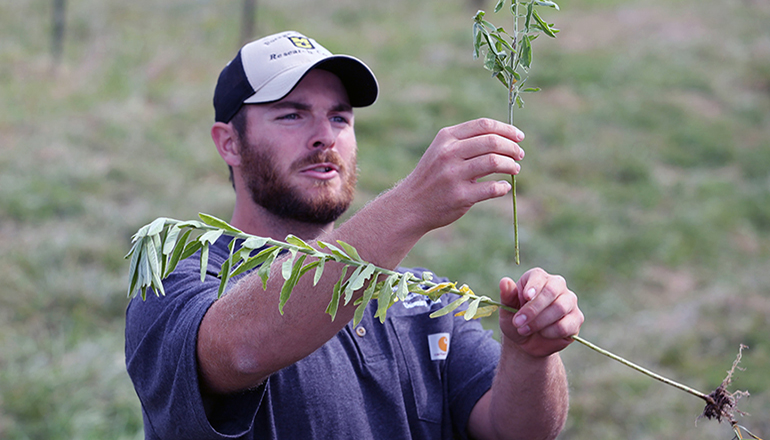Harley Naumann, an assistant professor in the Division of Plant Sciences, has a research and teaching appointment in forage physiology. His research focuses on understanding the critical physiological components of warm- and cool-season forages that lead to improved forage-livestock production systems.
Naumann has been working with a unique forage since he arrived at Mizzou in 2014 – sunn hemp. His work progressed into a methodology, with a focus on how producers could possibly incorporate sunn hemp into a tall fescue grazing system. Naumann’s research has continued to build on itself, leading to new projects and grants.
Josh Tooley, a graduate student in Plant, Insect and Microbial Sciences, has been working with Naumann on a recent project to see if intercropping sunn hemp can provide summer forage – and, if so, how it compares to the traditional nitrogen and non-nitrogen tall fescue systems in Missouri. The work is taking place at the Forage Systems Research Center (FSRC), in Linneus.
“It’s a very unique crop for sure,” Tooley said. “At the producer level, there are a few who are using sunn hemp. From a research standpoint, though, we’ve only found one other study where grazing sunn hemp was attempted. Within the scientific community, this is a novel project.”
Sunn hemp is a warm season annual crop, meaning that it thrives in warm weather. The extreme heat and drought through the summer actually helped the sunn hemp at FSRC.
“Having one of the hottest months of May in years was the best thing to happen to our sunn hemp,” Tooley said. “It has grown through the drought and heat. I’ve never worked with a forage that has been this drought hardy. And when sunn hemp is well watered, it does even better.
Tooley and Naumann are having the calves graze through three treatments – a nitrogen-fertilized tall fescue treatment, a no-nitrogen tall fescue treatment and a sunn hemp intercropped into tall fescue treatment.
“Once the calves learn to eat sunn hemp, they’ll eat it down to 12 inches, where the crop starts getting a little woody,” Tooley said. “It takes them about 24 hours to figure out that it’s good stuff. They’ll eat sunn hemp first and move to fescue once it’s all gone. So far, the sunn hemp seems to be their preference within this system.”
Along with the positive results in terms of grazing, Tooley noticed other interesting trends with the project in 2017.
“Forage quality is where we’re seeing the most interesting trend,” Tooley said. “Sunn hemp was terminated in early October of last year, due to frost, and the last quality sampling was done in November. We noticed that sunn hemp intercropped pastures had nearly 2 percent greater crude protein than unfertilized pastures at that time. The intercropped system was around 12.6 percent crude protein.
Tooley will go into more details about the project during the upcoming Forage Systems Research Center field day on Tuesday, Sept. 11, at the Center in Linneus. Registration begins at 8:30 a.m. and tours begin at 9 a.m. The event, as well as lunch, is free and open to the public.
“We’re excited to have Josh at our field day to talk about the sunn hemp research taking place at FSRC,” said David Davis, superintendent of the Center. “This work is incredibly unique, and I’m glad they are sharing some of the results with those in attendance.”
Tooley earned his undergraduate degree from MU in plant sciences. The grant is through the United States Department of Agriculture (USDA) National Institute of Food and Agriculture (NIFA).
Attached photo cutline: Josh Tooley (pictured), a graduate student in Plant, Insect and Microbial Sciences, has been working with assistant professor Harley Naumann on a recent project to see if intercropping sunn hemp can provide summer forage – and, if so, how it compares to the traditional nitrogen and non-nitrogen tall fescue systems in Missouri. The work is taking place at the Forage Systems Research Center (FSRC), in Linneus.
photo credit: Logan Jackson, University of Missouri







